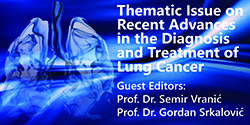Changes in lipid peroxidation, glutathione, ascorbic acid, vitamin E and antioxidant enzymes in patients with ovarian cancer
Keywords:
Ovarian cancer, Malondialdehyde, Glutathione, Superoxide dismutase, Catalase, Glutathione peroxidase, Glutathione -S - transferaseAbstract
Objective. This work was undertaken to assess oxidativestress and antioxidant status in patients with ovarian cancer.Patients and Methods. The study was conducted in thirtyeightpatients with ovarian cancer, the control group being 38healthy volunteers. Erythrocyte lipid peroxidation products(MDA), glutathione (GSH), ascorbic acid, plasma vitamin Eand activities of antioxidant enzymes super oxide dismutase(SOD), glutathione peroxidase (GPX), catalase in erythrocytesand plasma glutathione – S – transferase (GST) were estimatedin ovarian cancer patients. Results. In this study it wasobserved that there was a significant increase in erythrocyteMDA levels, SOD, GPX and plasma GST activities and a significantdecrease in erythrocyte GSH, ascorbic acid, plasmavitamin E levels and catalase activity in patients with ovariancancer when compared to controls. Conclusions. The resultsof our study suggest higher oxygen free radical production,evidenced by increased MDA and decreased GSH, ascorbicacid, vitamin E and Catalase activity, as support to theoxidative stress in ovarian cancer. The increased activities ofantioxidant enzymes may be a compensatory regulation inresponse to increased oxidative stress.References
Tas F, Hansel H, Belce A, Ilvan S, Argon A, Camlica H et al. Oxidative stress in ovarian cancer. Med Oncol. 2005;22(1):11-5.
Yeh CC, Hou MF, Tsai SM, Lin SK, Hsiao JK, Huang JC, et. al Superoxide anion radical, lipid peroxides and antioxidant status in the blood of patients with ovarian cancer. Clin Chim Acta. 2005;381(1-2):104 –11.
Sato M and Miyazaki T. Antioxidants inhibit tumor necrosis factor- alpha mediated stimulation of interleukin-8, monocyte chemo attractant protein-1 and collagenase expression in cultured human synovial cells. J Rheumatol. 1996;23(3):432-8.
Sie H. Oxidative stress: from basic research to clinical application. Am J Med. 1998; 9:31-8.
Cotgreave I, Moldeus P, Orrenius S. Host biochemical defense mechanisms against prooxidants. Annu Rev Pharmacol Toxicol. 1988;28:189-212.
Saroja M, Balasenthil S, Nagini S, Tissue lipid peroxidation and glutathione dependent enzyme status in patients with oral squamous cell carcinoma. Cell Biochem Funct. 1999;17:213-6.
Markman M. Ovarian cancer update: Management challenges and advances. Cleve Clin J Med. 1994;61:51-8.
Brandes JM, Lightman A, Draugu A, Zinder D, Cohen A, Itskovitig J. The diagnostic value of serum copper/zinc ratio in gynaecological tumors. Acta Obstet Gynaecol Scand. 1983;62:225-9.
Dodge JF, Mitchell G, Hanahan DJ. The preparation and chemical characterization of hemoglobin free ghosts of human red blood cells. Arch. Biochem. Biophys. 1968; 110:119-30.
Quist EH. Regulation of erythrocyte membrane shape by calcium ion. Biochem Biophys Res Commun. 1980;92:631-7.
Beutler E, Duron O, Kelly BM. Improved method for the determination of blood glutathione. J Lab Clin Med. 1963;61:882-8.
Varley H. Determination of plasma ascorbate by 2,6-Dichlorophenolindophenol titration. In: Gowenlock AH, McMurray JR, McLauchlan DM, editors. Varley’s Practical Clinical Biochemisttry. London: Heinemann Medical Books; 1988. p. 927.
Baker H, Frank O. Determination of serum tocopherol, In: Gowenlock AH, McMurray JR, McLauchlan DM, editors. Varley’s Practical Clinical Biochemistry. London: Heinemann Medical
Books; 1988; p. 902.
Jain SK, Mcvie R, Duett J, Herbst JJ. Erythrocyte membrane lipid peroxidation and glycosylated hemoglobin in diabetes. Diabetes. 1989;38:1539-42.
Misra HP, Fridovich I. The role of super oxide anion in the auto oxidation of epinephrine and a simple assay for super oxide dismutase. J Biol Chem. 1972; 247: 3170-75.
Beers RF, Sizer IW, A spectrophotometric method for measuring the breakdown of hydrogen peroxide by Catalase. J Biol Chem. 1952;195:133-40.
Paglia DE, Valentine WN. Studies on the quantitative and qualitative characterization of erythrocyte glutathione peroxidase. J Lab Clin Med. 1967;70: 158-9.
Warholm M, Guthenberg C, von Bahr C, Mannervik B. Glutathione transferases from human liver. In: Meister A, editor. Methods of enzymology. Newyork: Academic Press;1985. p. 500-501.
Nayak SB, Bhat VR, Mayya SS. Serum copper, ceruloplasmin and thiobarbituric acid reactive substance status in patients with ovarian cancer. Indian J Physiol Pharmacol. 2004; 48 (4):486-8.
K umaraguruparan R, Subapriya R, Kabalimoorthy J, Nagini S. Antioxidant profile in circulation of patients with fibrodenoma and adeno ovarian cancer. Clin Biochem. 2002;35: 275-9.
Gerber M, Astre C, Segala C, Saintot M, Scatt J, Simony- Lafontaine J, et al. Oxidant-antioxidant status alterations in cancer atients: relationship to tumor progression. Journal of Nutr. 1996;126:1201S-7S.
Saintot. M., Astre. C, Pujol H, Gerber M. Tumor progression and Oxidant and antioxidant status. Carcinogenesis. 1996;17:1267-71.
Upadhya S, Upadhya S, Mohan SK, Vanajakshamma K, Kunder M, Mathias S. Oxidant – Antioxidant status in colorectal cancer patients-before and after treatment. Indian Journal of Clinical Biochemistry. 2004;19 (2):80 -3.
Anuradha CV, Selvam R. Effect of oral methionine on tissue lipid peroxidation and antioxidants in alloxan induced diabetic rats. J Nutr Biochem. 1993;4:212-7.
Parks E, Traber MG. Mechanism of vitamin E regulation research over the past decade and focus on the future. Antioxid Redox Signal. 2002;2:405-12.
Senthil K, Aranganadhan S, Nalini. Evidence of oxidative stress in Ovarian Cancer. Clin Chim Acta. 2004;339(1-2):27-32.
Nonaka A, Manabe T. Effect of new synthetic ascorbic acid derivative as a free radical scavenger on the development of acute pancreatitis in mice. Gut. 1991;32: 528-32.
Skrzydiewska E, Stankiewicz A, Sulkowska M, Sulkowski S, Kasacka. I. Antioxidant status and lipid peroxidation in colorectal cancer. J Toxicol Environ Health. 2001;64:213-22.
Lenzi A, Cualosso F, Gandini L, Lombardo F, Dondero F. Placebo controlled double-blind cross over trial glutathione therapy, in male infertility. Hum Reprod. 1993; 9:2044.
Smith GJ, Ohl VS, Litwack G. Ligandin, the glutathione S-transferases, and chemically induced hepatocarcinogenesis: a review. Cancer Res. 1977;37(1):8-14.
Sinha BK, Mimnaugh EG, Rajagopalan S, Myres CE. Adriamycin activation and oxygen free radical formation in human breast tumor cells: Protective role of glutathione peroxidase in adriamycin resistance. Cancer Res. 1989;49:3844-8.






